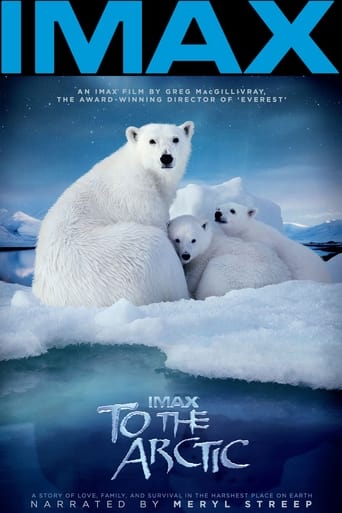

Meryl Streep narrates this environmental IMAX nature film. Paul McCartney provides the songs. There is a warning about global warming projecting declining ice-coverage to the year 2050. This follows a mother polar bear and her two cubs. There are also other life such as the herd of caribou, underwater life, and the people of the north. There is one particularly intense scene as the polar bear family is chased by a large male. Otherwise, the animal photography is functional without being exceptional. There are some beautiful grand sweeping vistas. I would have liked more underwater filming of the tiny creatures. As a nature film, this is good enough. The environmentalism can be grating. Sometimes, it's not necessary to preach so much.
... View MoreHere are 3 things that lost this exceptionally well-photographed, IMAX presentation some very serious points.(1) It contained some really pathetic, "grate-on-your-nerves" songs from 71-year-old, pop icon (and former-Beatle), Paul McCartney.(2) Its phone-in narration (which was absolutely "dry-as-a-bone") was lifelessly delivered by veteran actress, Meryl Streep.(3) This "message" documentary also got a bit out of hand when it came to driving home the point that it was, indeed, all man's fault for being the one who was creating all of the greenhouse gases that were causing global warming to accelerate (which, in turn, was destroying the arctic environment for polar bears and other such cold-climate wildlife).But, on the other hand - There certainly was some very outstanding camera-work done in this documentary whose story traced the journey of a mother polar bear and her two, 7-month-old cubs as they bravely navigated their way across the ever-changing arctic wilderness.
... View MoreThrough masterful and patient cinematography and editing, the movie documents a compelling story of survival. I was very much invested and fearful for the mother and her cubs, who were under the constant threat of attack by desperately hungry adult male bears, who were unable to otherwise feed themselves due to the effects of man's environmental recklessness on their habitat. Being a native IMAX movie, the picture quality is superb - way better than, say, Planet Earth or Arctic Tale. The presentation, the aerial shots, and the way the cameras take the viewer on the bears' journey is amazing. As for music, in addition to the Paul McCartney songs, there's also some beautiful original score by Steve Wood. Particularly the delicate celestial track that was also used on the Bluray's home menu screen gave me goosebumps. It's worth noting that a very tiny segment features footage shot using a remote controlled robotic digital camcorder, which (at the obvious expense of image quality) was able to capture the kind of up-close action that would've been impossible to get using the bulky and precious IMAX camera. However, rather than blow those scenes up to fill the entire screen, the movie has the honesty to put them in a sort of small ice-themed frame in the center, as if to say: "Look folks, these are some cool bits that we had to include but we're not by any means trying to pass them as 65mm film". This is something I came to appreciate having watched Hubble 3D, a movie where the vast majority of the non-CGI parts are cheap consumer camcorder footage (Am I watching an IMAX 3D movie or a reality TV show?). Anyway, if you love having your HD screen filled edge-to-edge with gorgeous full 16:9 65/70mm IMAX shots, you absolutely need to own To the Arctic 3D on Bluray.
... View MoreThe flick begins by mentioning that polar bears resulted from brown bears (grizzly bears) migrating to the Arctic and adapting to that environment, a theory that comports with accepted thinking. Unfortunately, the idea that polar bears might migrate south and re-adapt to a different climate totally escapes the biased story-line developer. Never have I heard such misguided and erroneous information about anthropogenic global warming and the plight of a subspecies. That said, the photography was exceptionally good in part. While providing a glimpse into the life of polar bears, the focus on their supposed plight became tedious and boring. Minor and limited photography of other wildlife and sea creatures was of interest if you can forget the overall bias. I have to wonder how the story-line might be altered if presented from the point of view of the seal - a primary source of food for the bear as presented by the flick. I also continue to ask myself the question, "Does Ms. Streep have the slightest clue why Greenland is so named when 80% is covered in ice today?". I certainly enjoyed much of the photography, though the film dragged at times and the bias caused attention to drag.
... View More